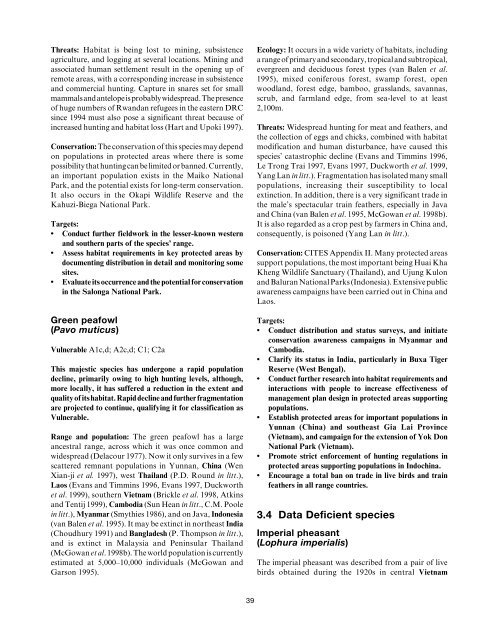Pheasants: Status Survey and Conservation Action Plan ... - IUCN
Pheasants: Status Survey and Conservation Action Plan ... - IUCN
Pheasants: Status Survey and Conservation Action Plan ... - IUCN
Create successful ePaper yourself
Turn your PDF publications into a flip-book with our unique Google optimized e-Paper software.
Threats: Habitat is being lost to mining, subsistence<br />
agriculture, <strong>and</strong> logging at several locations. Mining <strong>and</strong><br />
associated human settlement result in the opening up of<br />
remote areas, with a corresponding increase in subsistence<br />
<strong>and</strong> commercial hunting. Capture in snares set for small<br />
mammals <strong>and</strong> antelope is probably widespread. The presence<br />
of huge numbers of Rw<strong>and</strong>an refugees in the eastern DRC<br />
since 1994 must also pose a significant threat because of<br />
increased hunting <strong>and</strong> habitat loss (Hart <strong>and</strong> Upoki 1997).<br />
<strong>Conservation</strong>: The conservation of this species may depend<br />
on populations in protected areas where there is some<br />
possibility that hunting can be limited or banned. Currently,<br />
an important population exists in the Maiko National<br />
Park, <strong>and</strong> the potential exists for long-term conservation.<br />
It also occurs in the Okapi Wildlife Reserve <strong>and</strong> the<br />
Kahuzi-Biega National Park.<br />
Targets:<br />
• Conduct further fieldwork in the lesser-known western<br />
<strong>and</strong> southern parts of the species’ range.<br />
• Assess habitat requirements in key protected areas by<br />
documenting distribution in detail <strong>and</strong> monitoring some<br />
sites.<br />
• Evaluate its occurrence <strong>and</strong> the potential for conservation<br />
in the Salonga National Park.<br />
Green peafowl<br />
(Pavo muticus)<br />
Vulnerable A1c,d; A2c,d; C1; C2a<br />
This majestic species has undergone a rapid population<br />
decline, primarily owing to high hunting levels, although,<br />
more locally, it has suffered a reduction in the extent <strong>and</strong><br />
quality of its habitat. Rapid decline <strong>and</strong> further fragmentation<br />
are projected to continue, qualifying it for classification as<br />
Vulnerable.<br />
Range <strong>and</strong> population: The green peafowl has a large<br />
ancestral range, across which it was once common <strong>and</strong><br />
widespread (Delacour 1977). Now it only survives in a few<br />
scattered remnant populations in Yunnan, China (Wen<br />
Xian-ji et al. 1997), west Thail<strong>and</strong> (P.D. Round in litt.),<br />
Laos (Evans <strong>and</strong> Timmins 1996, Evans 1997, Duckworth<br />
et al. 1999), southern Vietnam (Brickle et al. 1998, Atkins<br />
<strong>and</strong> Tentij 1999), Cambodia (Sun Hean in litt., C.M. Poole<br />
in litt.), Myanmar (Smythies 1986), <strong>and</strong> on Java, Indonesia<br />
(van Balen et al. 1995). It may be extinct in northeast India<br />
(Choudhury 1991) <strong>and</strong> Bangladesh (P. Thompson in litt.),<br />
<strong>and</strong> is extinct in Malaysia <strong>and</strong> Peninsular Thail<strong>and</strong><br />
(McGowan et al. 1998b). The world population is currently<br />
estimated at 5,000–10,000 individuals (McGowan <strong>and</strong><br />
Garson 1995).<br />
Ecology: It occurs in a wide variety of habitats, including<br />
a range of primary <strong>and</strong> secondary, tropical <strong>and</strong> subtropical,<br />
evergreen <strong>and</strong> deciduous forest types (van Balen et al.<br />
1995), mixed coniferous forest, swamp forest, open<br />
woodl<strong>and</strong>, forest edge, bamboo, grassl<strong>and</strong>s, savannas,<br />
scrub, <strong>and</strong> farml<strong>and</strong> edge, from sea-level to at least<br />
2,100m.<br />
Threats: Widespread hunting for meat <strong>and</strong> feathers, <strong>and</strong><br />
the collection of eggs <strong>and</strong> chicks, combined with habitat<br />
modification <strong>and</strong> human disturbance, have caused this<br />
species’ catastrophic decline (Evans <strong>and</strong> Timmins 1996,<br />
Le Trong Trai 1997, Evans 1997, Duckworth et al. 1999,<br />
Yang Lan in litt.). Fragmentation has isolated many small<br />
populations, increasing their susceptibility to local<br />
extinction. In addition, there is a very significant trade in<br />
the male’s spectacular train feathers, especially in Java<br />
<strong>and</strong> China (van Balen et al. 1995, McGowan et al. 1998b).<br />
It is also regarded as a crop pest by farmers in China <strong>and</strong>,<br />
consequently, is poisoned (Yang Lan in litt.).<br />
<strong>Conservation</strong>: CITES Appendix II. Many protected areas<br />
support populations, the most important being Huai Kha<br />
Kheng Wildlife Sanctuary (Thail<strong>and</strong>), <strong>and</strong> Ujung Kulon<br />
<strong>and</strong> Baluran National Parks (Indonesia). Extensive public<br />
awareness campaigns have been carried out in China <strong>and</strong><br />
Laos.<br />
Targets:<br />
• Conduct distribution <strong>and</strong> status surveys, <strong>and</strong> initiate<br />
conservation awareness campaigns in Myanmar <strong>and</strong><br />
Cambodia.<br />
• Clarify its status in India, particularly in Buxa Tiger<br />
Reserve (West Bengal).<br />
• Conduct further research into habitat requirements <strong>and</strong><br />
interactions with people to increase effectiveness of<br />
management plan design in protected areas supporting<br />
populations.<br />
• Establish protected areas for important populations in<br />
Yunnan (China) <strong>and</strong> southeast Gia Lai Province<br />
(Vietnam), <strong>and</strong> campaign for the extension of Yok Don<br />
National Park (Vietnam).<br />
• Promote strict enforcement of hunting regulations in<br />
protected areas supporting populations in Indochina.<br />
• Encourage a total ban on trade in live birds <strong>and</strong> train<br />
feathers in all range countries.<br />
3.4 Data Deficient species<br />
Imperial pheasant<br />
(Lophura imperialis)<br />
The imperial pheasant was described from a pair of live<br />
birds obtained during the 1920s in central Vietnam<br />
39
















